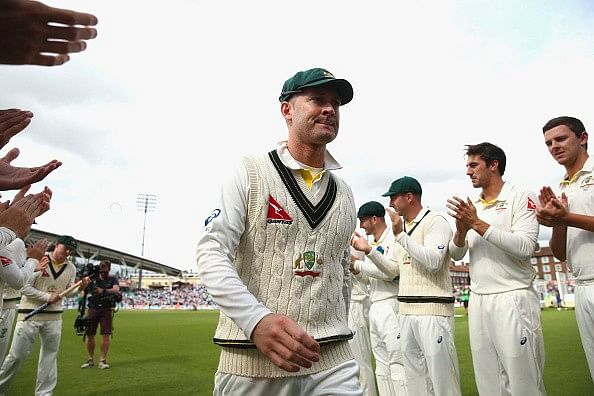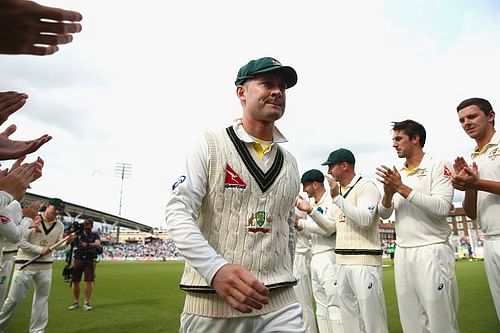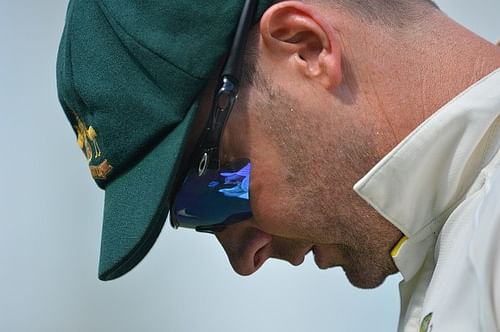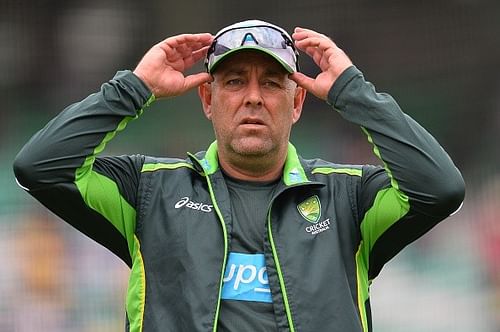
The aftermath of the Clarke era: Where does Australian cricket go from here?

For England, the euphoria of reclaiming the Ashes has been somewhat tempered by a chastening defeat in the last Test match. The loss might not have been enough to mar the mood of jubilation. For the Aussies however, it came almost as a divine intervention. When heroes fall, they clutch on to the very straws in desperation which at other times would have earned their contemptuous disdain.
A 3-2 result does look much better on paper and the victory has made it a successful swansong for Michael Clarke. The 34-year-old would have wanted to depart on a winning note and after he had earned the ire of quite a few former greats who went on to question his legacy, the Aussies were dying to give their skipper a valiant farewell.
But with Clarke having bowed out and the Test team going through a transitional phase, the obvious question remains: what does the future hold for Australian cricket? I have chosen to contemplate on this issue by means of a careful deconstruction of the problems present in Australian cricket which became evident during the recently concluded Ashes series.
Transitional phase in Australian cricket
Many could argue that it is only natural that the Australian team should go through a crisis now, given the fact that it happens to any team when they are going through a transitional phase. Without undermining the importance of the term, it has to be conceded that transitional phase is a convenient term that has been thrown around a lot in Australian cricket ever since Ricky Ponting entered the twilight phase of his career.
The Australian team that dominated world cricket for almost a decade starting from the late 90s was unarguably one of the best, comprising some of the most impressive legends of the game. Their departure has understandably opened up an unthinkable lacuna.
Not only was the Aussie aura of invincibility blatantly destroyed, but also for the first time, after a decade during which the opponents shivered looking at names like Waugh, McGrath, Warne and Gilchrist on the team sheet, an Australian team took to the ground comprising players who looked like mere mortals. The Clarkes and Watsons have carried the legacy forward, but they do not boast of the imposing presence of a Waugh or a McGrath.
The danger of succeeding a generation of legends is that your greatness is eclipsed as a result of a perpetual comparison. Just as one should remember the great generation of the Aussie greats for their contribution to the game, one must at the same time be acutely cautious of falling prey to the politics of nostalgia.
One does not need to look for the next Ponting or now, the next Clarke. One must rather celebrate the emerging greatness of a Steve Smith for what he is, learning to shed the burden of nostalgia makes us impersonal receptors who can accept the modern greats on their own terms.
Re-discovering the cult of being self-critical

There were times during the Ashes series when one felt that the Australian batsmen have forgotten to bat. With the full-length ball viciously swinging outside the off-stump, most of them abominably chose to reach out to the deliveries rather than leaving them alone. When the entire world was questioning the decision-making of the Australian batsmen, they themselves chose to play hardball in front of the media.
Michael De Venuto, the Australian batting coach chose to blame the heightened atmosphere of Edgbaston, the English conditions and, quite incredibly, the raucous nature of the English crowd. While blaming their lack of preparation, he said: "It's hard to get 30,000 people screaming at training. And I'm not too sure Stuart Broad and James Anderson want to come and bowl to us at training. So it's obviously hard at training to do that sort of thing, but we've all been in those situations before out in the middle."
David Warner seemed to be echoing Venuto’s sentiments when he said that the atmosphere was more conducive for football. "Especially over here, you look at the football," Warner said. "The crowds, the home teams - you hear all the songs and chants. Then you come over here and you're playing the Ashes and it's the same thing. The crowd is singing and they're always going to be behind the English. Sometimes it is hard."
Mitchell Johnson's boisterous relationship with the English crowd has been noted throughout the Ashes and it is indeed true that the English supporters who were at their vocal best did try to get under the skin of the Australian players. But the manner of the defeats was so embarrassing that it is juvenile to hold a tiny off-field factor solely responsible for it.
Australian greats have always carried themselves with a lot of dignity and it is unbecoming of them to hunt for petty excuses which run the risk of them being dubbed as disgraceful losers. In the battery of excuses used by the Australians, starting from the altitude to the crowd and the cloudy conditions, one cannot help finding inadvertent parallels with Jose Mourinho's antics.
Mourinho has singularly mastered the art of deflecting criticism - there is now even a Jose Mourinho excuse generator online - and if there is anything the Australians would love to borrow from him, it would only be his ruthlessness and clinical precision.
The Australian legends of the past never sniggered in the face of self-criticism. And Michael Clarke, perhaps the last of these old school Aussie greats was immensely likeable primarily because he has never stepped away from criticising himself. Commenting on his recent form, he famously said that they were “playing with only ten men.” If the Aussies want to be world beaters again, the ruthlessness they would like to re-invigorate in themselves would come with the responsibility of being self-critical.
How responsible was England’s home advantage for the Ashes defeat?
The Australians being skittled out for a paltry score of 60 does sound like ‘fantasy cricket’ in the first instance. But the truth is stranger than fiction. The Australians who were wallowing in their overconfidence - Smith predicted a convincing Ashes win for the Australians before the series - tottered and whimpered against the moving delivery. They struggled to get bat on ball and the ball kept finding the edges with an enviable precision.
How much of the Australians' bemoaning the foreign, hostile conditions is justifiable? Cricket lovers around the world who have been following with an obvious sense of disappointment the developments in the modern game have time and again highlighted the escalating significance of home advantage. Graeme Swann, the only member of a team who has won an away Ashes series in recent times, beautifully summed it up:
"The Aussies come here and nick everything. We go there and get bumped out. That is it in a nutshell."
When asked to explain, Swann added, "For me it is quite simple. In England the wickets are getting slower so the batsmen are not being exposed to fast bouncy wickets. When they go to Australia it is a culture shock. They can't deal with these guys with raw pace on fast, bouncy wickets. Then, when you come to England and the ball still swings, even the visiting batsmen that play county cricket don't face the highly skilled swing bowling they do in Tests. Batsmen don't like the ball moving laterally through the air. It is bad enough when it is jagging about off the pitch."
Without the extra pace and bounce, bowlers like Johnson and Starc who were supposed to bulldoze the opposition in this series, turned out to be rather meek and insipid. There was no chin music when Johnson was bowling; the only music was when the lanky Aussie quick puffed his cheeks and gobbled his spit before resuming his run up every time.
It came from the raucous Barmy Army who were having a great time in the stands. And when Anderson and Broad ran in, it was the lateral movement off the seam that spelled doom for the Australian batsmen.
Statistician Andrew Samson re-affirms our doubts about home advantage in his analysis of Ashes Tests. According to his study, prior to 2002, 117 Ashes Tests were won by the home team and 98 by the away team. That makes it a decent win/loss ratio of 1.19 in the matches that yielded a result. After 2002, however, this ratio goes for a spin. The home team has been victorious in Ashes Tests on 25 occasions while the visitors have won a meagre 7 matches since then.
The Aussies almost like every other team have been poor travellers of late and have failed to acclimatise to foreign conditions. Many feel that this Ashes series could have had a completely different outcome if the Aussies were playing at home. But there will be many more Ashes series in England after this and the Australians must find a way to play lateral movement better.
The next generation of emerging Aussie Test cricketers should earnestly consider the option of playing plenty of English county cricket whenever possible as it would stand them in good stead while preparing for playing in the English conditions. It has to be remembered that the great Waugh brothers spent a considerable amount of time playing county cricket for Essex and Kent.
Australian batsmen looked indecisive against the swinging ball
It is unthinkable now that the legendary Sunil Gavaskar once scored 36 off 174 balls in an ODI match. The reason why that sounds impossible to believe now is because the game has changed leaps and bounds in modern times. The influence of T20 cricket has left an indelible mark on the modern game so much so that the idea of occupying the crease just for the sake of it is passé now.
It's a cliché to state that the hallmark of a good Test batsman is his ability to defend well and having a good awareness of where his off stump is. But this simple minded approach is not easy to implement for a generation of batsmen growing up on ODI and T20 cricket.
The propensity of the Australian batsmen to go hard at the ball outside the off-stump has cost them dear throughout the series. Warner, Smith, Clarke and Vogues - that makes it the Australian top order basically - have been too reluctant to leave the ball and slashed hard at it, only to end up nicking it to the slip cordon.
Against the swinging ball, all of them looked extremely uncomfortable and indecisive. The greatness of a batsman lies in his ability to adapt to different conditions - modern day batsmen cannot afford to be comfortable with a particular style of play that has been tailored to suit him only in home-grown conditions.
As we grapple with the rather ominous question of what lies ahead for Australian cricket, it is difficult to be optimistic about the chances of the English batsmen doing well in these conditions in the near future. The reason why I am saying this is because the problem that the Australians seem to be facing should not be viewed in isolation. It would be wiser perhaps to view this as a symptom of the problems haunting Test cricket in modern times.
The majority of the game is played out in the head and in the dressing room before one takes the field. For a generation of cricketers growing up on their fair dose of T20 cricket, the natural propensity for trying to score runs leads to the ignominious downfall of many a batsman in trying conditions.
The only fathomable solution might seem to be to keep the two worlds apart and have separate specialist batsmen for Test matches. The only problem is with the number of Test matches being played seriously decreasing and the mushrooming of lucrative T20 leagues around the world, there are not too many players these days who grow up idolising Test cricket.
There have been odd occasions when players like Rahul Dravid and Jacques Kallis have felt like anachronisms in their coloured outfits but over time, they learned to adapt. Many people earnestly believe that the adjustment is considerably tougher for ODI and T20 specialists when they play Test cricket.
In the name of being positive, we do see a lot of shots in Test cricket nowadays which would have been inexplicable a few decades ago. There are a quite a few upcoming Australian batsmen who would make it to the Test squad now but they should find a way of tightening up their defences when the ball is delivered in the so-called corridor of uncertainty.
Darren Lehmann will have to re-build now

When teams are outplayed in an embarrassing fashion, captains and coaches become the favourite whipping boys. There is a rising sense of indignation against Australia's head coach Darren Lehmann under whom the Australians have lost two Ashes series now.
That public sentiment is stacked against him as was evident from the recent harsh treatment meted out to him on social media. When Lehmann recently tweeted to find out if anyone could arrange for tickets to a Liverpool versus Stoke City match in the Barclays Premier League, what he encountered instead was unforeseen humiliation.
Cricket Australia CEO James Sutherland put all doubts to rest in the aftermath of the Ashes defeat when he emphatically emphasized that Lehmann would continue as the head coach. Lehmann who is an immensely revered figure in the Australian domestic circuit has also led the national team to an Ashes win and a world cup victory.
Many thought Lehmann would quit in the aftermath of the disastrous Ashes campaign but that he has decided to stay put speaks volume of his valour and dedication.
Lehmann will now have to work with a completely new set of players in the team and at this time of transition in Australian cricket, he might just be the man to see Australia out of the troubled times and lead them out of the woods. Sutherland has, however, called for self-introspection on the aggressive brand of batting that failed repeatedly during the series: “After every series we will sit down and review, and I think there is an opportunity for a reflection on [our] style of play."
It will be back to the drawing board for the Australians after this sobering series defeat and if Lehmann has to continue, he should have has his work cut out from now. There is plenty of time until the next Ashes series and the Australians will set that as a long time goal to start building a decent Test outfit all over again.
Fresh faces set to come in
?
As many as eight players from the current team might never play Test cricket again was Ricky Ponting's ominous prophecy. Clarke and Rogers have retired. Haddin and Watson's Test careers seem to be all but over. The only certainty in Australian cricket at the moment is that barring Smith and Warner, a completely new set of players might don the baggy green in the days to come.
The Australian Test team was an ageing side and people have been crying out to inject some young blood into the team. There is, of course, no paucity of promising young talents who could make it to the squad. Shaun Marsh is being touted by many to be the most eligible candidate to seal the opening slot vacated by Rogers' retirement. But Marsh is bound to face stiff competition from the likes of Joe Burns, Cameron Bancroft and Ed Cowan.
Though Burns batted at no. 6 in the two Test matches against India last summer, much of his success for Queensland has come while batting at the top of the order. At 22, Bancroft looks like a frightening talent being the third highest scorer in this Sheffield Shield season and having scored a magnificent century against India A recently. Big things are also expected of Travis Head, an elegant southpaw from Adelaide and the Melbourne-born Peter Handscomb who currently plays for Gloucestershire.
In the bowling department, Hazlewood and Starc are likely to retain their places while Peter Siddle should enjoy a decent run of games given the form that he is in. James Pattinson is expected to make it back to the squad and if, as expected by many, Nathan Coulter-Nile and Sean Abbot earn a maiden Test call-up, the bowling department does look more than promising to say the least.
And in Steve Smith, Australia do have the ablest possible successor of Michael Clarke. Once a maverick lower-order batsman who made it to the limited overs team mainly as a bowling all-rounder, the metamorphosis of Smith has been nothing short of extraordinary.
Smith has really grown from strength to strength and turned into one of the most reliable top order batsmen for Australia. Clarke said with an immense sense of confidence that he was leaving Australian cricket in safe hands which show the trust and confidence that Smith already enjoys among his teammates.
It's not as bad as it seems
The next generation of Australian cricketers do look promising if only on paper as of now. If all the important factors that led to the Ashes defeat are carefully taken into consideration, the future of Australian cricket looks far from ominous.
It is particularly difficult for teams when they are going through a transitional phase and one can hope that Australia will find the right combination of players to build a team now that can do well for years to come. I have tried to argue that it is deeply unfair to blame the Australian batsmen for their tentativeness and bad decision making while playing the moving ball.
The ills of trying to dominate the bowling in hostile conditions in Test matches have been felt by many teams in recent times. One must view these issues within the larger context of how Test cricket is trying to fight a losing battle against its shorter and more lucrative, glamorous counterpart.
And one can never downplay the issue of home advantage. If the Australian batsmen were continuously nicking Anderson and Broad in this Ashes series, the English batsmen, we should remember, were unconvincingly bounced out in the previous Ashes.
The most interesting fact is that all the matches in this series ended in emphatic victories and what is being conveniently forgotten is that England was thoroughly outplayed in two Tests. There were a few good moments for the Australians during the series even if they seem to be irrelevant now in the light of the larger context. In Smith's majestic flair and Nevill's penchant for guts and gumption, we might have already seen glimpses of a promising future.
For decades, the Australian quicks have steamrolled the English batsmen in one Ashes series after another. "Ashes to Ashes, dust to dust, if Thomson don't get ya, Lillee must" would sing the Australian crowd baying for blood. The hunger and derision in their cry were unmistakable. And now decades later, we have two English bowlers making the ball talk.
The swing and seam that they have managed to elicit from the red cherry is almost a new, dangerous poetry of vicious candour. If an entire cricketing fraternity has now embarked upon a mission to mock the Aussies after an Ashes defeat, it should be forgiven as a moment of pent up catharsis. There is no reason to panic contemplating a bleak future for Australian cricket. For all the criticism being directed at the Australian team now, the sense of schadenfreude should not be ignored.